SIT Global Health and Human Rights
Majors: Public Health and Sociology
Certificate: Social Dimensions of Health
Pre-departure
Hey everyone!
It’s your favorite study abroad ambassador back again! My name is Emmanuella Osei, and this is my second time being an ambassador and my fourth time studying abroad. Since being at UMBC, I have participated in shorter programs, including a faculty-led trip to South Africa in Summer 2023, a January-term program in Costa Rica through AIFS, and a trip to Switzerland as part of an international health course I took last semester. This semester, I’m thrilled to take you all along with me as I spend four months in Kenya through the SIT Global Health and Human Rights program! At UMBC, I’m pursuing dual degrees in Public Health and Sociology, with a certificate in Social Dimensions of Health.
Studying abroad for an entire semester is not something I thought I could do…but here we are. After all my previous short-term programs, I always left wanting more. That’s why I decided to do a semester-long program this time, to truly immerse myself in the country. While this experience will definitely be out of my comfort zone, I am looking forward to challenging myself and the growth I will gain by the end of the semester.
In Kenya, I’ll be taking courses like global health, epidemiology, research methods, health and human rights, and Kiswahili (the language spoken in Kenya and much of East/Southern Africa). These classes will take place at SIT’s program center based in Kisumu, Kenya, where we will spend the majority of our time. I’ll also be living with a host family, and I’m excited to meet and get to know them soon. Beyond the classroom, the program includes excursions throughout Kenya and even a trip to Tanzania!
So, why Kenya? As someone originally from Ghana in West Africa, I knew that if I chose a long-term study abroad program, it had to be somewhere in Africa. This is a special opportunity to learn about East Africa and gain public health experience in a new context. When I discovered that SIT offered a Global Health and Human Rights program in Kenya, it felt like the perfect fit. While I’ll miss my family, friends, and UMBC community, I know this journey will be deeply meaningful. I’m especially excited for the excursions, the cultural immersion of my homestay, and the new family I’ll be gaining in Kenya.
Right now, I’m sitting at JFK Airport waiting to board my 14-hour flight to Nairobi. Once I land, I’ll hop on another short flight to Kisumu, where the program is based. From what I know, a few other students in the program are on my flight too, so I’m excited to start meeting everyone soon!
When we get to Kisumu, we’ll stay in apartments for a few days of orientation before moving in with our host families for the rest of the semester. I can’t wait to share all my adventures with you as I settle into life in Kenya. Stay tuned!
Kwaheri (bye)!
In-Country Post 1
I can’t believe I’ve already been in Kisumu, Kenya, for more than a week! After arriving on September 1st, we stayed in apartments for three days before many of us moved into our homestays. When applying to this program, I had the choice between living in a homestay or staying in the apartments, and I chose the homestay option as I know it will allow me to be more immersed in the culture.
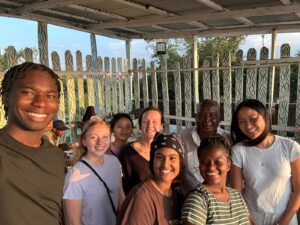 During our first week in Kisumu, we went through orientation to get to know the city better, bond as a group, and explore different restaurants. On our very first night, we had dinner at an Indian restaurant, which was delicious and much needed after a long travel day! Something I’ve already witnessed here is the presence of Indian families in Kisumu, many of whom have lived in Kenya for generations. It’s been fascinating to see their cultural influence, especially in food. Many Kenyans list samosas and chapati among their favorite dishes. Another staple food here is ugali, often eaten with fish. Being right by Lake Victoria, Kisumu is well known for its fish, and I’ve had the chance to visit lakeside restaurants and see beautiful sunsets. Lake Victoria is Africa’s largest lake by area, the world’s largest tropical lake, and the second-largest freshwater lake in the world. The dominant ethnic group in Kisumu is the Luo, and it’s been wonderful learning more about their traditions, cultural practices, and ways of life.
During our first week in Kisumu, we went through orientation to get to know the city better, bond as a group, and explore different restaurants. On our very first night, we had dinner at an Indian restaurant, which was delicious and much needed after a long travel day! Something I’ve already witnessed here is the presence of Indian families in Kisumu, many of whom have lived in Kenya for generations. It’s been fascinating to see their cultural influence, especially in food. Many Kenyans list samosas and chapati among their favorite dishes. Another staple food here is ugali, often eaten with fish. Being right by Lake Victoria, Kisumu is well known for its fish, and I’ve had the chance to visit lakeside restaurants and see beautiful sunsets. Lake Victoria is Africa’s largest lake by area, the world’s largest tropical lake, and the second-largest freshwater lake in the world. The dominant ethnic group in Kisumu is the Luo, and it’s been wonderful learning more about their traditions, cultural practices, and ways of life.
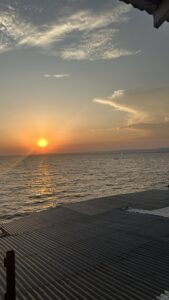 As I mentioned in my last blog, I’m taking courses here including Research Methods and Ethics (RME), Health and Human Rights (HHR), Comparative Healthcare Systems (CHS), and Kiswahili. Alongside coursework, we’re also preparing for our independent research projects or internships, which will take place during the final month of the program. I’ve already learned so much about Kenya’s history and healthcare system. Classes are taught by a mix of community members and our program director, which gives us multiple perspectives. With only eight people in the program, we get to have really in-depth discussions, which I love. For Kiswahili, we’re split into two smaller groups of four students each, which makes it even easier to practice and learn.
As I mentioned in my last blog, I’m taking courses here including Research Methods and Ethics (RME), Health and Human Rights (HHR), Comparative Healthcare Systems (CHS), and Kiswahili. Alongside coursework, we’re also preparing for our independent research projects or internships, which will take place during the final month of the program. I’ve already learned so much about Kenya’s history and healthcare system. Classes are taught by a mix of community members and our program director, which gives us multiple perspectives. With only eight people in the program, we get to have really in-depth discussions, which I love. For Kiswahili, we’re split into two smaller groups of four students each, which makes it even easier to practice and learn.
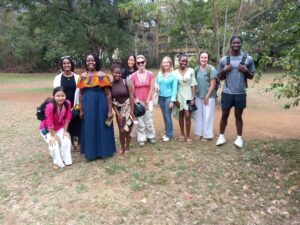 I’m sure you’re wondering what it’s like to live with people I didn’t know a week ago. Before arriving, each of us received a welcome letter from our host families, which definitely eased my nerves. On move-in day, my host mom and her older son picked me up, and once we got home, I met the rest of the family. I also got to speak with her daughters who live elsewhere over the phone. Adjusting to a new home and culture has had its challenges, but each day I feel more comfortable. My host mom has been incredibly welcoming, constantly reminding me that I’m now part of their family and that I should always feel free to express my needs.
I’m sure you’re wondering what it’s like to live with people I didn’t know a week ago. Before arriving, each of us received a welcome letter from our host families, which definitely eased my nerves. On move-in day, my host mom and her older son picked me up, and once we got home, I met the rest of the family. I also got to speak with her daughters who live elsewhere over the phone. Adjusting to a new home and culture has had its challenges, but each day I feel more comfortable. My host mom has been incredibly welcoming, constantly reminding me that I’m now part of their family and that I should always feel free to express my needs.
Looking ahead, I’m excited about our upcoming site visits. Tomorrow we’ll be visiting Kisumu County Referral Hospital and speaking with staff there. So far, it’s been eye-opening to learn about the healthcare system not only from teachers but also from conversations with our homestay families. Visiting the hospital will add another layer of understanding, and I’m looking forward to sharing more about my experiences in Kenya soon.
Kwaheri!
In-Country Post 2
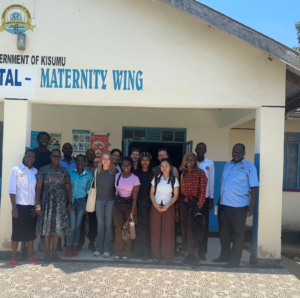
Mambo!
It’s hard to believe I’ve already been in Kisumu for almost a month. Since my last post, my days have been filled with lectures from health professionals, hospital visits, Kiswahili classes, and fun activities with my program group.
Two weeks ago, we visited Kisumu County Referral Hospital (KCRH), our first public hospital. A staff member provided an overview of the services offered and the major challenges the facility faces, before leading us on a tour of the wards. Seeing the conditions firsthand was disheartening. Like many public hospitals in Kenya, KCRH is under-resourced and understaffed, with far more patients than it can handle. It was sad to see mothers sharing beds immediately after giving birth because of the limited space.
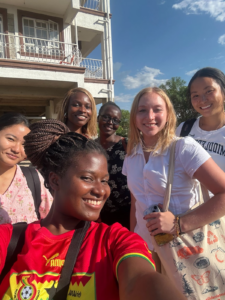 A few days later, we toured Inuka Hospital, a private facility in Milimani, the area where my program is based. The contrast was striking. Inuka had stronger infrastructure, more staff, and sufficient resources. The patient-to-provider ratio was far more manageable: one nurse was responsible for about six patients, compared to over 60 in public facilities. The quality of care was noticeably higher, but of course, only patients with private insurance or the ability to pay significant out-of-pocket expenses could access such services.
A few days later, we toured Inuka Hospital, a private facility in Milimani, the area where my program is based. The contrast was striking. Inuka had stronger infrastructure, more staff, and sufficient resources. The patient-to-provider ratio was far more manageable: one nurse was responsible for about six patients, compared to over 60 in public facilities. The quality of care was noticeably higher, but of course, only patients with private insurance or the ability to pay significant out-of-pocket expenses could access such services.
This past week, we also learned about Community Health Promoters (CHPs), who form the first level of Kenya’s six-tier healthcare system. Each CHP is responsible for approximately 100 households per month, providing basic health check-ups and carrying medical kits to diagnose and treat conditions such as malaria on-site. They can also refer patients to higher-level facilities when needed. After learning about their work, we had the chance to join them on household visits. Yesterday we visited a peri-urban area, and today we traveled to three homes in a rural community. These visits were eye-opening, underscoring both the importance of CHPs and the challenges they face. Because CHPs are embedded in their communities, they are trusted and able to connect with households in meaningful ways. Yet their work is impeded by low compensation, supply shortages, and limited support.
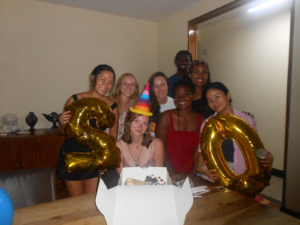 Outside of our site visits, we have our Kiswahili class almost every morning. It has been exciting to start forming short sentences, and I get to practice more at home with my host sisters, which has been both helpful and fun.
Outside of our site visits, we have our Kiswahili class almost every morning. It has been exciting to start forming short sentences, and I get to practice more at home with my host sisters, which has been both helpful and fun.
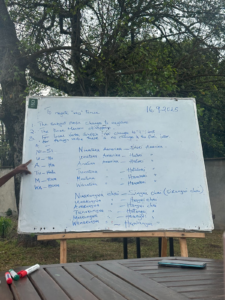 There has also been plenty of time to enjoy Kisumu outside of academics. Our group visited Dunga Hill Camp by the lake, where we enjoyed live music and beautiful views. We often visit each other’s homestays, and recently gathered for a birthday dinner. I have also enjoyed attending different churches each week which has allowed me to explore various parts of Kisumu and meet other people!
There has also been plenty of time to enjoy Kisumu outside of academics. Our group visited Dunga Hill Camp by the lake, where we enjoyed live music and beautiful views. We often visit each other’s homestays, and recently gathered for a birthday dinner. I have also enjoyed attending different churches each week which has allowed me to explore various parts of Kisumu and meet other people!
Overall, the past few weeks have been a balance of learning and fun. Lectures have given us different perspectives on Kenya’s healthcare system, but visiting hospitals and households has truly brought those lessons to life. This experience has strengthened my passion for healthcare access, and I am eager to keep exploring the health landscape in various parts of Kenya.
Next Monday, we will fly to Mombasa, on the coast, where we’ll spend a week studying healthcare access in that region. Afterward, we will spend a few days in Nairobi, the capital, before traveling to Tanzania for about a week. I am extremely excited for the upcoming travel and all the new experiences we will have!
Tuonane badaaye!
In-Country Post 3: Discovering Health and Culture Across Kenya and Tanzania
Jambo!
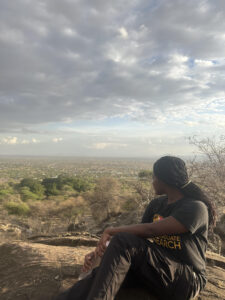 When I first landed in Kenya seven weeks ago, I could hardly imagine how quickly time would fly. Each week has brought new lessons both inside and outside the classroom. From visits to health facilities to conversations with health workers and community members, I’ve seen how culture, geography, and community shape health seeking behaviors and outcomes. The last two weeks were especially memorable, filled with travel across Kenya’s coast, the bustling capital of Nairobi, and even into Arusha, Tanzania.
When I first landed in Kenya seven weeks ago, I could hardly imagine how quickly time would fly. Each week has brought new lessons both inside and outside the classroom. From visits to health facilities to conversations with health workers and community members, I’ve seen how culture, geography, and community shape health seeking behaviors and outcomes. The last two weeks were especially memorable, filled with travel across Kenya’s coast, the bustling capital of Nairobi, and even into Arusha, Tanzania.
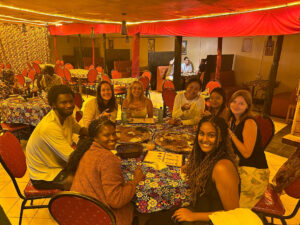 We first flew to the coast of Kenya, where we spent five days. It was fascinating to experience how different the culture is on the coast compared to Kisumu. On the coast, we learned about coastal culture and how it influences people’s interactions with the healthcare system. Our lecturer discussed the importance of traditional medicine and how many people rely on it, especially during COVID-19, which is believed to have reduced deaths in the region.
We first flew to the coast of Kenya, where we spent five days. It was fascinating to experience how different the culture is on the coast compared to Kisumu. On the coast, we learned about coastal culture and how it influences people’s interactions with the healthcare system. Our lecturer discussed the importance of traditional medicine and how many people rely on it, especially during COVID-19, which is believed to have reduced deaths in the region.
We also visited Kwale County Referral Hospital, a level 4 facility which was much less crowded than Kisumu County Referral Hospital. The doctor we met highlighted both the hospital’s recent improvements, like adding an oncology department, and its ongoing challenges, such as staff shortages. Additionally, we spoke with community health promoters (CHPs) and compared their work to CHPs in Kisumu County, where my program is based.
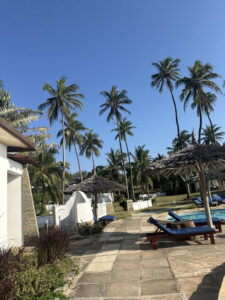 Of course, there was also time for fun! We stayed at a beautiful hotel on Tiwi Beach and spent a day at Diani Beach, one of Kenya’s most famous beaches. After our time on the coast, we took a six-hour train to Nairobi for the weekend. I was finally able to go to a Ghanaian restaurant since there aren’t any in Kisumu. It was also interesting to witness how populated and busy Nairobi is in comparison to Kisumu which is much less crowded.
Of course, there was also time for fun! We stayed at a beautiful hotel on Tiwi Beach and spent a day at Diani Beach, one of Kenya’s most famous beaches. After our time on the coast, we took a six-hour train to Nairobi for the weekend. I was finally able to go to a Ghanaian restaurant since there aren’t any in Kisumu. It was also interesting to witness how populated and busy Nairobi is in comparison to Kisumu which is much less crowded.
After Nairobi, we drove to Arusha, Tanzania. The main goal there was to learn about Tanzania’s healthcare system and visit different health facilities. On our first day, a doctor gave us an overview of the system, and then we visited his workplace—Mount Meru Regional Hospital. The hospital had a calm atmosphere and impressive infrastructure, with clean, well-maintained grounds.
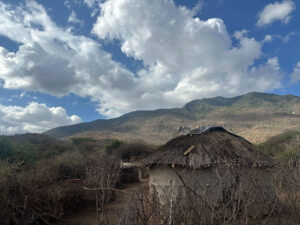 A few days later, we traveled to Longido, also in the Arusha region. There, we visited both a district hospital and a local health center. Our primary objective was to learn about the Maasai community, their culture and health practices. We discovered that the Maasai rely heavily on traditional medicine and rarely visit hospitals, which explained why both facilities had few patients. We were fortunate to visit a Maasai boma (a traditional homestead) and learn about their semi-nomadic lifestyle. The Maasai are pastoralists who herd cattle and goats, which provide their main food sources—milk, meat, and blood. During our visit, they even offered us goat blood to try, and a few of my peers were brave enough to do so! It was an incredible cultural exchange and one of the most memorable parts of the trip so far.
A few days later, we traveled to Longido, also in the Arusha region. There, we visited both a district hospital and a local health center. Our primary objective was to learn about the Maasai community, their culture and health practices. We discovered that the Maasai rely heavily on traditional medicine and rarely visit hospitals, which explained why both facilities had few patients. We were fortunate to visit a Maasai boma (a traditional homestead) and learn about their semi-nomadic lifestyle. The Maasai are pastoralists who herd cattle and goats, which provide their main food sources—milk, meat, and blood. During our visit, they even offered us goat blood to try, and a few of my peers were brave enough to do so! It was an incredible cultural exchange and one of the most memorable parts of the trip so far.
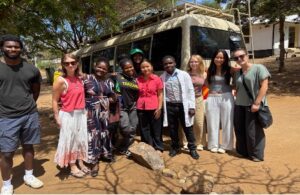 After Longido, we drove back to Nairobi and then flew to Kisumu. Overall, the past two weeks have been incredibly insightful. It was fascinating to compare the healthcare systems in Kisumu, coastal Kenya, and Tanzania. Now, we have a few more weeks of classes before beginning our internships or independent study projects. Each of us will choose a topic or site we’ve visited to focus on. I’m leaning toward doing a project related to community health promoters, the first level of Kenya’s healthcare system, but I’m looking forward to narrowing down my interests in the coming weeks.
After Longido, we drove back to Nairobi and then flew to Kisumu. Overall, the past two weeks have been incredibly insightful. It was fascinating to compare the healthcare systems in Kisumu, coastal Kenya, and Tanzania. Now, we have a few more weeks of classes before beginning our internships or independent study projects. Each of us will choose a topic or site we’ve visited to focus on. I’m leaning toward doing a project related to community health promoters, the first level of Kenya’s healthcare system, but I’m looking forward to narrowing down my interests in the coming weeks.
As I look back on these past two weeks of travel, I’m reminded of how deeply culture shapes every aspect of health: what care people seek, how they define wellness, and who they trust. Seeing these differences across regions and countries has broadened my understanding of global health beyond what I could learn in a classroom. Each experience, from visiting hospitals to sharing moments with the Maasai, has deepened my appreciation for the resilience and resourcefulness of communities across East Africa. I’m excited to carry these lessons forward as I continue my studies and prepare for my next chapter here in Kenya.
In-Country Post 4
Hello everyone,
Welcome back to my blog! We’re now in the final stretch of classes before transitioning into our independent study projects and internships. These last few weeks have been filled with learning, exploration, and moments that have helped me better understand both Kenya’s health system and its sociopolitical landscape. Here’s an update on what I’ve been up to in Kisumu!
Since returning to Kisumu two weeks ago, we have spent a lot of time preparing for our independent study projects (ISPs) and internships. As I mentioned in earlier blogs, my program consists of about 11 weeks of coursework followed by 4 weeks of an ISP/internship. We are currently in week 9, which means only two more weeks of classes (and two more weeks with our homestay families) before moving back into apartments for our project period.
Last week, we had a series of sessions focused on global health research methods and ethics. We practiced analysing de-identified data from a local health facility and learned different approaches to collecting data responsibly within communities. These sessions have been incredibly useful as we prepare to begin our own fieldwork.
A major national event also took place at the end of last week. Former Prime Minister Raila Odinga passed away, which deeply affected the country, especially here in Kisumu, where he has strong roots and a loyal support base. For many, he represented hope and political change, particularly within the Luo community. As a result, Friday was declared a public holiday, and Monday was already a national holiday: Mashujaa Day (“Heroes’ Day”), which honors those who contributed to Kenya’s independence and development. Although somber, being here during such a significant moment has given me a deeper understanding of Kenya’s politics and the emotions tied to leadership and identity.
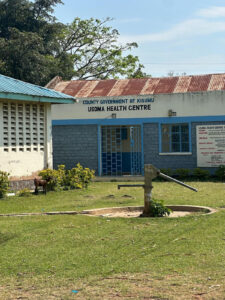 This week, we visited Usoma Health Centre, located about 30 minutes from our program site in a peri-urban community. Because of environmental and infrastructural factors, Usoma faces health challenges such as malaria and respiratory illnesses. Staff at the health center also described issues like limited personnel, which stretch their capacity and impact the quality of care they can provide.
This week, we visited Usoma Health Centre, located about 30 minutes from our program site in a peri-urban community. Because of environmental and infrastructural factors, Usoma faces health challenges such as malaria and respiratory illnesses. Staff at the health center also described issues like limited personnel, which stretch their capacity and impact the quality of care they can provide.
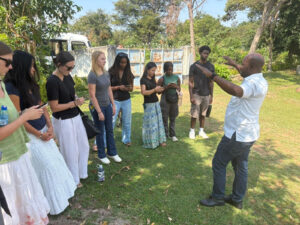 The next day, we returned to Usoma for focus group discussions. We engaged with four groups — older men, older women, younger men, and younger women — to better understand barriers to healthcare access. My partner and I met with older women in the community. They shared concerns about frequent medication stock-outs, long travel distances to access care, and the costs associated with seeking treatment. Listening to their firsthand experiences reinforced the importance of community-centered approaches in public health.
The next day, we returned to Usoma for focus group discussions. We engaged with four groups — older men, older women, younger men, and younger women — to better understand barriers to healthcare access. My partner and I met with older women in the community. They shared concerns about frequent medication stock-outs, long travel distances to access care, and the costs associated with seeking treatment. Listening to their firsthand experiences reinforced the importance of community-centered approaches in public health.
These past few days have left me feeling both motivated and curious. I’m eager to continue exploring healthcare access challenges, and I will likely focus my project on Usoma, inspired by the conversations we’ve had this week.
I can’t wait to share more once fieldwork begins in a couple of weeks! Stay tuned for updates from the next chapter of my global health journey in Kenya.
In-Country Post 5
Karibu (welcome) to another blog! These past few weeks have felt completely different from the start of the program. So much happened all at once: our classes ended, we moved out of our homestays and into apartments, I started my independent study project, and my friends and I took a trip to Nairobi. It’s been filled with incredibly fun and meaningful learning experiences.
Now that classes are officially over (which is crazy because this semester flew by), we suddenly have way less structure. As long as we’re meeting the goals of our independent projects, we can pretty much build our schedules however we want. Honestly, it’s been really nice to not feel stressed and to have staff members who are genuinely flexible and supportive. I also love that we didn’t have any high-stakes, anxiety-inducing exams. Of course, we still had assignments and papers, and I had to write a full research proposal, but it all felt manageable. Even our Swahili oral exam felt more like a casual conversation with my mwalimu (teacher). And lately, it’s been cool to have simple conversations in Swahili, whether I’m buying something, greeting people on the street, or introducing myself.
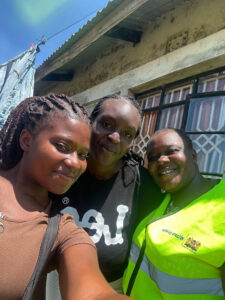 Now onto my research project: I decided to conduct an independent study in Nyalenda, a nearby peri-urban community. I designed a survey assessing health-seeking behaviors, the barriers people face in accessing healthcare, and any recommendations they have. I’ve been working with community health promoters (CHPs) to distribute the survey in two wards in Nyalenda. At the end of last week, I went with the CHPs to the first location and watched as they administered the survey. Since many people in the area primarily speak Swahili or Luo, working with the CHPs has been essential as they translate, explain, and create trust with participants.
Now onto my research project: I decided to conduct an independent study in Nyalenda, a nearby peri-urban community. I designed a survey assessing health-seeking behaviors, the barriers people face in accessing healthcare, and any recommendations they have. I’ve been working with community health promoters (CHPs) to distribute the survey in two wards in Nyalenda. At the end of last week, I went with the CHPs to the first location and watched as they administered the survey. Since many people in the area primarily speak Swahili or Luo, working with the CHPs has been essential as they translate, explain, and create trust with participants.
Visiting households with them has been incredibly insightful. I was able to see firsthand the living conditions in Nyalenda and understand the disparities between Milimani (where I’m staying) and Nyalenda, even though they’re right next to each other. Hearing directly from people who use the healthcare system, and listening to their recommendations, has been one of the most meaningful parts of my project. All of these results and feedback will be shared with the county Department of Health at the end of my study.
Of course, in the middle of my research I had to take a quick, fun trip to Nairobi. The last time I was there was with my program, and we were in the city for less than two days between the Coast trip and heading to Tanzania. After that glimpse of Nairobi, I knew I had to come back and spend more time there. So I went with two of my friends for about four days, and we had such a good time!
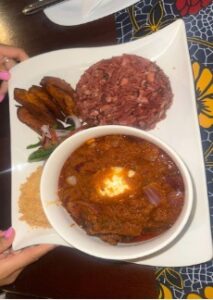
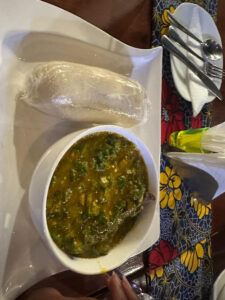 Naturally, my first stop was Ghanaian restaurants. Nairobi has an incredible food scene, and there’s so much international presence. Aside from eating good food, we also packed in a bunch of fun activities: visiting the Museum of Illusions, going to a comedy show,dancing at a salsa/bachata night, hanging out with friends, and just exploring the city. We had a great time and I’ll definitely be back in the future.
Naturally, my first stop was Ghanaian restaurants. Nairobi has an incredible food scene, and there’s so much international presence. Aside from eating good food, we also packed in a bunch of fun activities: visiting the Museum of Illusions, going to a comedy show,dancing at a salsa/bachata night, hanging out with friends, and just exploring the city. We had a great time and I’ll definitely be back in the future.
 Now I’m back in Kisumu continuing my project. Today I went to my second location, met up with the community health promoters, and started administering more surveys. Once all my data is collected, I’ll analyze everything, write my final report, and present my findings to the Kisumu County Department of Health at the end of the program.
Now I’m back in Kisumu continuing my project. Today I went to my second location, met up with the community health promoters, and started administering more surveys. Once all my data is collected, I’ll analyze everything, write my final report, and present my findings to the Kisumu County Department of Health at the end of the program.
It’s crazy to think that in less than a month I’ll be back in the U.S. My time here has gone by so fast, but I’m extremely grateful for this opportunity and so glad I pursued it. I’m also excited to return home because I miss my family and friends, but Kenya will always have a special place in my heart!
See you in my next blog!
In-Country Post 6
 Habari kila mtu (hello everyone)!
Habari kila mtu (hello everyone)!
Since my last update, it’s been a relaxing but productive two weeks as I wrapped up my independent research project. At the end of my previous blog, I had just returned from my data collection site. A few days later, the Community Health Promoters (CHPs) I was working with finished gathering data for the quantitative portion of my study. I also interviewed two of them, which helped further contextualize my findings.
Throughout this research project, I have learned so much and gained a lot more confidence in my research abilities. This was my first time conducting a study where I visited households to collect data, supported by trusted community health workers. It was incredible to see how welcoming everyone was. Even though I wasn’t present for every survey, I am extremely grateful for the CHPs who made this study possible. This was also my first time interviewing people as part of a study, and speaking with the CHPs gave me valuable insights into the healthcare system.
From the surveys and interviews, I learned more about the barriers people face when trying to access care. The most common challenges were medication shortages in facilities and the financial barriers patients experience. A major issue involved Kenya’s universal health coverage program, the Social Health Authority (SHA). Many respondents were registered for SHA, but they still faced financial challenges because the system network would frequently be down—meaning they had to wait or pay out of pocket. Others could no longer afford the annual or monthly SHA payments, so their coverage became inactive.
Tomorrow, we will all be presenting our research and internships from the past four weeks to staff and members of the Department of Health. I’m looking forward to learning about what everyone studied during this time.
 Aside from research, we’ve also had a lot of fun as a group! We have enjoyed attending live music events, dance classes, karaoke nights, and more. About two weeks ago, we also had a Friendsgiving where we all cooked and spent time together.
Aside from research, we’ve also had a lot of fun as a group! We have enjoyed attending live music events, dance classes, karaoke nights, and more. About two weeks ago, we also had a Friendsgiving where we all cooked and spent time together.
 This past weekend, we had a farewell lunch with our host families—the wonderful people we lived with during the first two months of the program. It was great to see not just my host family but everyone else’s as well, and to reminisce about our experiences. Living with a host family helped us feel more integrated into the culture and taught us so much that we might not have learned otherwise.
This past weekend, we had a farewell lunch with our host families—the wonderful people we lived with during the first two months of the program. It was great to see not just my host family but everyone else’s as well, and to reminisce about our experiences. Living with a host family helped us feel more integrated into the culture and taught us so much that we might not have learned otherwise.
 After the lunch, many of us attended a wedding! Believe it or not, the bride was once a study abroad student through the same SIT program about seven years ago. She met her now-husband, who is Kenyan, during her time abroad. Now, years later, we current SIT students had the honor of attending their wedding. It was beautiful and so cool to witness!
After the lunch, many of us attended a wedding! Believe it or not, the bride was once a study abroad student through the same SIT program about seven years ago. She met her now-husband, who is Kenyan, during her time abroad. Now, years later, we current SIT students had the honor of attending their wedding. It was beautiful and so cool to witness!
It’s crazy that I have just one more week left here in Kenya, and I already know I’m going to miss it so much. But I’m excited for the next few days as we’ll be heading on safari after our final presentations. Stay tuned for my last in-country blog!
Kwaheri!





